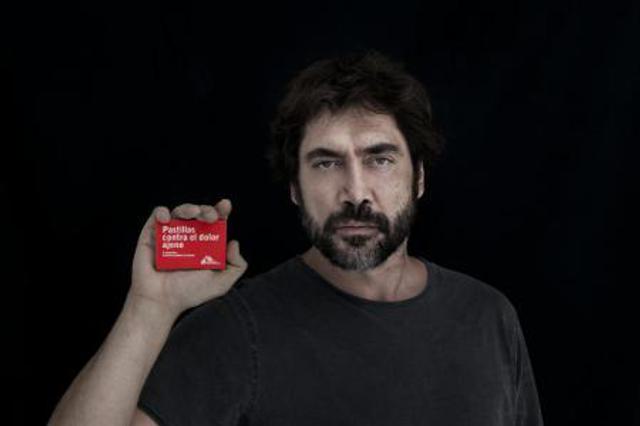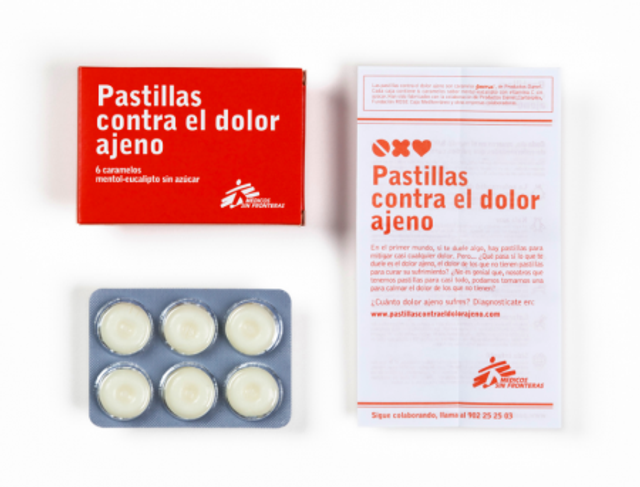Medicos Sin Fronteras: medicine for someone else’s pain
- Exhibited by
- Melanie Scagliarini, Amnesty International.
- Added
- June 12, 2012
- Medium of Communication
- Online, Posters, Retail
- Target Audience
- Awareness, single gift.
- Type of Charity
- Healthcare, international relief/development.
- Country of Origin
- Spain.
- Date of first appearance
- November, 2010.
SOFII’s view
It would be wonderful if we could take all our donors to visit our offices, or projects, or beneficiaries wherever in the world they might be. But life isn’t often that kind. So instead we have to help our donors to know and feel how the causes they love are changing the world for the better.
Medicos Sin Fronteras have managed this with the great idea of getting their donors to imagine, feel, the pain that a lot of the people they work with are suffering. Then they show in a tangible way how the money that they receive is helping to alleviate that pain. When we in the developed world feel pain we take a pill, now when we feel someone else’s pain we can buy a pill that will ease that person’s pain.
Creator / originator
Medicos Sin Fronteras.
Summary / objectives
To raise awareness and earn €3 million in three months to fund MSF projects around the world for the six ‘forgotten illnesses’ (as the MSF website refers to them) in an environment that is struggling with the economy and rife with charity fatigue. The six illnesses are:
- Chagas disease.
- Infant AIDS.
- Sleeping sickness.
- Malaria.
- Tuberculosis.
- Kala azar.
Background
The campaign ran from November 2010 – February 2011.
There is a saying in Spain about making the final euro last until the end of the month so the idea was to ride on that one euro. The thinking behind the campaign was to make the cost of giving more tangible: people see the packet and feel they are benefiting too.
MSF wanted to ensure that supporters understood where the funds went and to link any emotion they felt clearly to the campaign and to the illnesses. As the website says, ‘Pills for another person’s pain is a project of awareness and also a new symbol of hope’. It positions this further by explaining that supporters are feeling other people’s pain and if we buy and take the pills it will help alleviate that person's pain.
MSF dwells on this further by explaining that the more pills we take the more other people’s pain goes away. Expanding on the key emotions chosen to drive this campaign, the website also clarifies that they are actually selling love: ‘the main ingredient of the pills for somebody else’s pain is love.
‘In the developed world, if something hurts, we take a pill. But what happens to the other world’s pain, to the pain of those who don't have a pill?’ The language of the campaign uses medical terms, such as providing ‘prescriptions’, ‘diagnosing the pain’ we are feeling (for someone else’s pain) etc and positions the campaign as a medical issue that can be alleviated by buying the pills.
Special characteristics
The campaign uses huge, in stature and amount, celebrity endorsement, in particular the actors Javier Bardem and Luis Tosar who have recorded videos and been poster-boys for the campaign. There are many, many posters and videos of celebrities (film directors, actors, chefs, writers, footballers, well-known scientists, etc) talking about the pills and encouraging people to buy them. There are also videos of the same celebrities showing photos of real people around the world who are suffering from these illnesses and talking in more detail about the sufferer’s lives.
There is also an area on the website that has some well-produced videos of Bardem and Tosar screaming for other people’s pain. And you’re then invited to record your own scream and sign a petition.
The campaign has its own social media channels on Twitter, Facebook and YouTube.
Some points on the website:
- It places huge emphasis on the idea of feeling someone else’s pain yourself.
- The writing tone is a little formal but quite approachable.
- The user is able to prescribe these pills for another person’s pain to friends, family and neighbours via ‘a forward [a prescription] to a friend’ embed. This script also partners with Hotmail, Yahoo! and Gmail to allow the user to sign in and use their existing contacts list.
- There is an online diagnosis tool that tells the user about one of the six illnesses it is campaigning against and asks if you are feeling the sufferers’ pain yourself. If you say yes, then the site prescribes you the pills (if you say no then the site tells you that probably due to distance you are not in pain, but should you start to feel this pain MSF can help).
- It’s very interactive: as well as the above partnership with Hotmail, etc, it has an area that asks people to leave written comments, video comments and/or photos.
- An online petition asks you to sign your name and record a shout, scream, or written comment. But, if you prefer, you can sign the petition without recording or writing any comments).
- There is a donation page.
- There are a lot of clearly laid out details, with videos, describing the illnesses.
- An activist area: you can request an activist pack that contains posters, a book of prescriptions and campaigning letter.
- There is a large media area that allows the user to easily download any image he or she wants (of the celebrities or product) and videos.
The point-of-sale product:
- The pills are actually six sweets that are packaged in a blister pack – just like the real thing. There is even an instructions leaflet, only this time it is says things like ’If you are still feeling pain go to our website’. Each of the six pills represents a particular illnesses.
- The pills were sold in 21,000 participating pharmacies around the country.
Influence / impact
Number of boxes of pills distributed until 24 February 2011: three million (75 per cent sold in the first half of the campaign).
- Revenue: € 2,757,310.
- Revenue for the treatment of Chagas disease: €807,310.
- Revenue for the treatment of HIV/AIDS: €1,950,000.
- Thousands of messages were tweeted every day by hundreds of people.
- Tens of thousands of people were encouraged by their friends, family and other contacts to buy the pills.
- The website had over 500,000 visits by the end of the three months and 510,000 copies were made of YouTube videos.
So far, this has enabled MSF to cover the annual cost of their project in Bolivia. In 2010, 5,500 people were tested for Chagas disease and, so far, over 4,000 patients have been treated.
Money raised has also covered three quarters of the cost of two projects in Zimbabwe that treats 11,000 HIV/AIDS patients each year in collaboration with the Ministry of Health.
Medicos Sin Fronteras have won 10 awards (mainly in ‘best campaign’ categories).
The next aim is to take this campaign to Argentina and then to other Latin American countries.
Costs
Each packet cost 20 cents to make. The breakdown is as follows:
- Seven cents for production costs.
- Five cents for handling and packing.
- Eight cents for VAT.
Price per packet was €1 each.
The full 80 cents profit from the sale of each packet goes directly to MSF projects.
In addition, MSF engaged many corporate partnerships purely for the cause, which resulted in various organisations, companies and people working almost for free or at cost. The official colleges of pharmacists and the major distribution companies in Spain also supported the campaign, which kept costs to a minimum.
Merits
A well-executed marketing campaign, the medicine packet is creative, maxmimises the idea of making fundraising more tangible to the supporter and clearly outlines where the funds will go. The delivery through pharmacies ensures that the target audience will resonate with the message: access to medicines.
SOFII's I Wish I'd Thought Of That 2012 - No.21 Reuben Steains presents Medicos Sin Fronteras
























